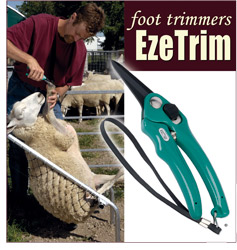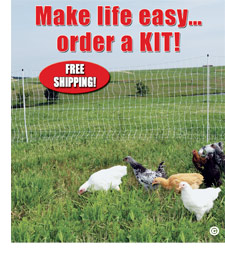Message from the Owner
Small Farms and Gardens
|
 |
EzeTrim Foot Trimmers
These are small trimmers, especially useful for folks with small hands. Secure locking mechanism.
EzeTrim Foot Trimmers
part #751100, $13 (reg. $16)
Order soon! Price good through July 15, 2009 or while supplies last!
Premier Photo Contest
 |
Net Fence Photo Contest — Winners receive a $100 Premier gift certificate!
Send us your photos of Premier's netting in use on your farm or around your home. Netting is a versatile tool.
So take your best photos and send them to us. Make sure the photos are in focus and the background is as clean as possible (no extra stuff in the photos).
Any photos that are used in our catalog or on our website will be credited, and the sender will receive a $100 Premier gift certificate.
Here are the specifics:
The photo needs to be in digital format (jpeg) in high resolution (300 dpi). We are accepting only digital photos. Send as many photos as you like.
The net in the photo needs to be Premier's net, used for any purpose.
Identify the type of net and the energizer that is powering it. Write a very short paragraph explaining its use.
Send it to cmiller@premier1supplies.com. Include your name, address and daytime phone number in an e-mail message.
We will contact winners as they are selected. They will receive a photo release form to sign and send back to us.
For Sale
 |
Livestock Guard Dog Puppies for Sale:
- Premier has 2 pups available.
- Born May 12. Will be weaned July 1.
- Polish Tatra/Spanish Mastiff crosses.
- Parents are working guard dogs at Premier that were obtained as pups from Janet McNally and Cindy Wolf.
- These puppies introduced to lambs at 4 weeks of age.
- We're keeping 4 siblings for use on Premier's farms.
- Call Jean for details @ 319-461-1129.
- $400 each.
Premier Tip
 |
How to secure electrified rope without assistance
This time of year I often find myself working alone on fences. When using electrified rope (any of it), I use P Springs and RopeLinks. The goal is to have the P springs half compressed when everything is all put together.
However, because I don't have a helper to hold the tension on the rope, I was losing too much tension in the process of getting the RopeLink wrapped around the rope.
My solution: I now attach the P Spring to the terminal insulator and loop my rope through it twice. Then I pull the rope tight so the P spring is FULLY compressed. When I get the RopeLink attached, I have lost some of the tension on the rope, but my P Spring is half compressed just like it should be.
by Premier Sales Consultant, Mandy Farrier
Premier Product
 |
PoultryNet Fence Systems™
Don't know what you need…order a Kit!
Step 1 - Choose one of these PoultryNet Kits
- 42" PoultryNet Kit (#201930) - Includes: 42" Single Spike PoultryNet and 5 extra support posts
- 42" PoultryNet Kit (#201935) - Includes: 42" Double Spike PoultryNet and 5 extra support posts
- 48" PoultryNet Kit (#201940) - Includes: 48" Single Spike PoultryNet and 5 extra support posts
- 48" PoultryNet Kit (#201945) - Includes: 48" Double Spike PoultryNet and 5 extra support posts
Step 2 - Choose one of these Energizer Kits
- Battery Energizer Kit (#201970)
- Plug-In Energizer Kit (#201975)
- PS15 Solar Energizer Kit (#201976)
View our complete line of poultry products.
Premier VIP
Dealing with Sheep Parasites
by Scott P. Greiner, Extension Animal Scientist, Virginia Tech
As sheep producers we welcome the onset of spring with return of the flock to pasture and access to lush forages. Along with this, however, we recognize that parasite season is also upon us. The most significant health issue faced by sheep producers is internal parasites. Throughout the U.S., and especially in the mid Atlantic and southern states, the most important member of this family is the barber pole worm (Haemonchus contortus). The barber pole worm is a parasite that feeds on blood, found in the stomach. Infected sheep become anemic, leading to poor performance and frequently death. Bottle jaw is a classic symptom of H. contortus infection; along with loss of condition, weakness, and rough appearance (parasitic infection may or may not be accompanied by diarrhea).
Control of internal parasites has been complicated by the development of resistance to many of the dewormer drugs available. This resistance has been brought about by several factors, including improper use of dewormers. Our dependence on dewormers as the primary mechanism to control parasites has resulted in prolonged exposure of the parasites to the drugs, and over time the parasites have developed resistance. Overuse and improper use of dewormers also contributes to development of resistance, and over time parasites which are susceptible to the dewormers have been killed off, leaving a population of parasites that are highly resistant. This extent of resistance will vary greatly from farm to farm. Given the prevalence of drug resistant worms and lack of new products entering the market in the near future, parasite control programs must utilize strategies in combination with dewormers to control parasites is necessary. These strategies are important even for flocks which do not have a resistance problem, as they will slow the development of resistance and prolong effective use of dewormers.
The following outlines several factors regarding an integrated approach to parasite control:
Pasture Management and Grazing Strategies
The life cycle of the worm involves the shedding of eggs in the fecal matter of the sheep. Given the right environmental conditions (warm and humid), these eggs hatch and the larvae migrate up the blades of forage and are then ingested by grazing sheep. The majority of the larvae are found in the first 2 inches of forage. Consequently, grazing management strategies that minimize overgrazing and leave a residual amount of forage (>2 inches) are conducive to reducing parasitism. Stocking rates are closely related to these factors, and flocks which have lower stocking densities tend to have lower parasite loads. This is a result of less grazing pressure, and the dilution effect of having fecal eggs and resulting larvae spread out over a larger land area.
The use of clean pastures has long been a strategy to control parasites. A clean pasture is one that is not contaminated with parasite larvae. This may be a pasture that has been cut for hay, grazed by another species (cattle or horses), or rested. Recent research indicates that the rest period needs to be at least 3 months, and 6 to 12 months in some cases. Most farms lack the acreage to rest pastures this amount of time.
Multi-species grazing of sheep with cattle or horses is an additional strategy that can be implemented. Since the parasites that affect these species are different, co-grazing helps to reduce the population of infective larvae available to the sheep since some of the population is consumed by cattle (and therefore do not propagate).
Proper Use of Dewormers
Dewormer products available for sheep fall into three drug classes:
- Benzimidazoles: Includes albendazole (Valbazen) and fenbendazole (Safeguard)
- Macrolides: Includes ivermectin (Ivomec) and moxydectin (Cydectin)
- Nicotinics: Includes levamisole (Tramisol, Prohibit)
Resistance has been documented in all of the above drug classes, and commonly reported for the white dewormers (albendazole, fenbendazole) and ivomectin. The only definitive way to determine if a flock has resistance is to conduct a fecal egg count reduction test, which will objectively determine the effectiveness of a particular dewormer in the flock. This test can be performed with the assistance of a veterinarian or extension agent.
Ideally, dewormers should be rotated on a yearly basis, using a product from different drug class each grazing season. This is becoming more challenging with the development of resistance and reduced market availability of levamisole.
When administering dewormers, be sure to accurately dose the animal, which requires accurate assessment of weight. Always dose for the heaviest animal in the group. Deworming sheep on an empty stomach may assist in the effectiveness of the deworming. Hold sheep off feed or pasture 24 hours prior to treatment (do not withhold water).
Strategic and Selective Deworming
To effectively control parasites we have evolved our approach from deworming all animals at regular intervals, to a strategic approach in which we deworm less frequently and concentrate on high-risk animals. The most recent approach includes strategic deworming, which involves evaluating and treating individual animals based on their parasite load.
As compared to ewes, lambs are at much higher risk of parasitism as a result of less immunity. The previously mentioned grazing strategies are important particularly with grazing ewes nursing lambs. Stocking rate and forage management in conjunction with well-timed dewormings should be utilized for this production group. Lambs will exhibit the effects of parasitism well before ewes, so monitoring of grazing lambs should guide treatment protocols. Weaning and grazing lambs separate from mature sheep assists in parasite management for both groups of sheep. When separated, lambs should graze "cleaner" pastures with more forage availability.
It has been demonstrated that the majority of the parasite problems in flocks are the result of a small proportion of the sheep. Methods that identify these problem animals and eliminate them from the flock assist in controlling parasites and reducing resistance. Animals that are chronically wormy are good candidates to cull.
An important step in controlling the development of resistance is to reduce the number of deworming treatments.� By reducing the number of treatments, the goal is to reduce the number of worms that are exposed to the drug and thereby become resistant.� The FAMACHA system has been developed for this purpose, and utilizes color of the eye membranes to assess anemia (related to parasite load), and allows for treatment decisions to be made on an individual animal basis. To implement FAMACHA, producers need to attend an educational session to obtain training and the eye-color chart used as the decision-making tool.� Contact your local extension agent for details regarding training.
FAMACHA also provides a mechanism for identifying and selecting both parasite resistant and highly susceptible sheep. Since each animal is scored individually, keeping records over time will assist producers in identifying the genetics in their flock that are problematic and/or most adaptable to their parasite management program.
Summary
Managing parasites is essential to sheep enterprise profitability. A number of strategies are available which reduce the dependence on dewormers, and implementation of these strategies is necessary to address drug resistance that has become widespread in recent years. Each flock will be unique in the techniques which equate to a successful parasite management program. Forage and grazing management and prudent use of dewormers need to be matched to the production system and resources of an individual farm. Stocking rate, forage quantity and quality, grazing practices, and flock genetics are all contributing factors that will impact a planned parasite control management program.
Horse Fences that Work
 |
Premier's Horse Fence Website
www.horsefencesthatwork.com
- Exclusively horse fences
- Enriched with diagrams, photos, "dos & don'ts"
- Simple online ordering
- Most items shipped free
You can still visit www.premier1supplies.com for all species and products.
Premier Employee Spotlight
 |
Sarah Anderson
This month's featured employee is Sarah Anderson, our summer farm intern. She has been working at Premier for seven weeks, assisting on the farm and during lambing.
Sarah says the best part about Premier "being outside, learning new things and the variety of the work being accomplished." What she likes best about Premier are "all of the great people. Everyone is very nice and very welcoming and so easy to get along with."
Sarah and her father have a 40-acre, grass-based sheep farm that consists mainly of Polypay ewes. They have been direct marketing their lambs for about 10 years. She says their biggest challenge is having enough space to run more sheep based on the demand of their direct lamb program. Many of their customers are Muslims, so they have not castrated their ram lambs for the past two years. Their greatest reward, she adds, is being able to set their own price for their lamb and not having to rely on market price.
Sarah's future plans are to attend a nearby community college, majoring in farm management. Then she plans to do missionary work. She says her favorite statement is: "We love Him because He first loved us (John 4:19). It shows us that no matter how bad and undeserving we are, that we don't have to be afraid of wanting God's friendship because He wants us."
Recipes
Poppy Seed Salad
Ingredients:
Lettuce
Spinach
Slivered almonds
Craisins (sweetened dried cranberries)
Salad dressing:
1/2 cup sugar
1/3 cup lemon juice
2 teaspoons onion, finely chopped
1 teaspoon Dijon mustard
1/2 teaspoon salt
2/3 cup oil
1 tablespoon poppy seeds
Combine dressing ingredients in a jar. Close, shake and refrigerate.
Combine a variety of lettuce and spinach in bowl. Add dressing just before serving and garnish with slivered almonds and Craisins.
from Jacque Sieren, Premier Employee
Spanish Lamb Tapas in Tomato, Lemon & Mint Sauce
(Adapted from the Colorado Lamb Book.)
Serve with prepared couscous or rice.
Preheat oven to 350 degrees.
Ingredients:
Spice mix
1 teaspoon cinnamon
2 teaspoons salt
3 teaspoons paprika
Pinch of cayenne pepper
Meatballs
1 lb ground lamb
2 tablespoons olive oil
1/2 of spice mix (above)
Sauce
1 small red onion, finely diced
1/2 of spice mix
4 fresh tomatoes, cored and chopped; OR 1-1/2 cups canned, chopped tomatoes (I prefer the canned tomatoes)
1/2 cup water
Juice of one lemon
2 strips (each 2 inches long) of lemon zest
6 fresh mint leaves, chopped; keep extra mint for garnish
Heat olive oil over medium heat, add onion and cook until soft (do not brown). Add 1/2 of spice mix and saute until fragrant. Add tomatoes and water; simmer uncovered for 15 minutes.
While sauce is simmering, combine lamb and other 1/2 of spice mix. Roll meat mixture into 20 tiny meatballs and place 1/2 inch apart in an oven-proof casserole.
Pour sauce over meatballs and sprinkle with 1/2 of lemon juice, lemon zest and 2/3 of chopped mint. Bake for 20 minutes.
Prepare couscous or rice.
Remove casserole from oven. Remove lemon strips. To serve, spoon over cooked rice or couscous. Sprinkle with remaining mint and lemon juice. Garnish with mint leaves.
4 servings


